Elevate Your Deck Design With Personalized Finishes
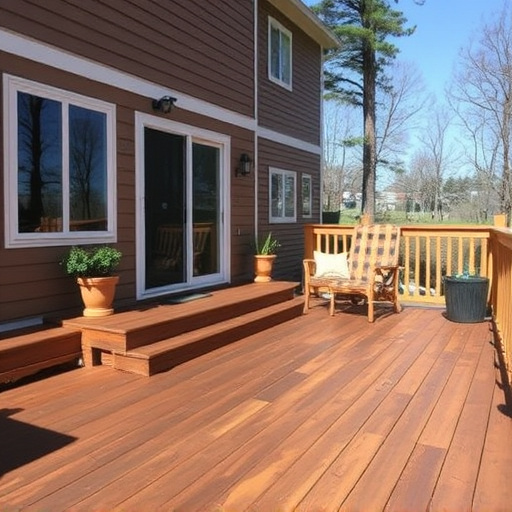
Personalize your deck design with flooring color choices that blend outdoor aesthetics with interior…….
In a world where outdoor living is increasingly valued, deck design has emerged as a powerful tool to transform spaces into vibrant, functional areas that seamlessly blend indoor and outdoor experiences. This article delves into the intricate world of deck design, exploring its various facets, global influence, economic implications, technological innovations, regulatory frameworks, and future potential. By understanding the art and science behind creating decks, we can unlock their full potential to enhance our homes, communities, and overall quality of life.
Definition: Deck design refers to the planning, designing, and construction of elevated outdoor platforms or structures, typically attached to residential properties. It involves a harmonious blend of architecture, engineering, and aesthetics to create functional and visually appealing spaces.
Core Components:
Structure: The framework that supports the deck, including joists, beams, and posts, is fundamental. Materials like wood, steel, or composite materials are chosen based on durability, load-bearing capacity, and aesthetic appeal.
Decking Material: Options range from traditional wooden boards (e.g., cedar, treated pine) to modern composite decking, offering various colors, textures, and maintenance levels.
Railings and Guardrails: Safety is paramount. Railings and guardrails provide protection against falls, with regulations dictating height requirements and spacing for horizontal and vertical rails.
Deck Surfaces: Besides traditional wood, options include concrete, tile, pavers, or specialized decking materials designed for specific uses, such as pool decks.
Lighting: Integrated lighting enhances the deck’s ambiance, safety, and usability, with choices ranging from recessed lights to string lights and solar-powered fixtures.
Historical Context: Deck design has deep roots in traditional architecture, with early decks serving practical purposes, like extending living spaces or providing access to outdoor areas. Over time, it evolved to include more intricate designs, incorporating ornate railings and decorative elements, especially in Victorian-era homes. The modern deck design movement gained momentum in the mid-20th century, driven by advancements in building materials and a growing desire for outdoor entertainment spaces.
Deck design is a global phenomenon, but its interpretation and implementation vary across regions, influenced by climate, culture, and local aesthetics:
North America: Known for its diverse deck styles, from simple wooden platforms to elaborate multi-level structures. The use of composite decking has gained popularity due to low maintenance and durability.
Europe: European decks often showcase intricate wood carvings and traditional designs, with a focus on comfort and al fresco dining. Recent trends include incorporating sustainable materials and biophilic design elements.
Asia: Asian countries like Japan and China exhibit unique deck concepts, such as elevated wooden platforms (in Japan) and open-air terraces with built-in seating (in China). The emphasis is often on creating serene spaces for relaxation and social gatherings.
Latin America: Colorful, vibrant designs are the norm, featuring intricate tile work and decorative railings. Outdoor living is deeply ingrained in Latin American culture, making decks integral to social interactions and entertainment.
Trends Shaping Global Deck Design:
Sustainability: There’s a growing demand for eco-friendly materials, with recycled composite decking, reclaimed wood, and natural fibers gaining traction.
Integration of Technology: Smart decking solutions include built-in speakers, LED lighting, and app-controlled climate control systems, enhancing the deck’s functionality and entertainment value.
Biophilic Design: Incorporating natural elements like plants, water features, and organic materials creates a connection with nature, promoting well-being and relaxation.
The deck design industry is a significant contributor to the global construction market, with varying economic dynamics across regions:
| Region | Market Size (Estimated 2023) | Average Deck Construction Cost (USD) |
|---|---|---|
| North America | $15 billion | $10,000 – $25,000 |
| Europe | $8 billion | $7,000 – $15,000 |
| Asia-Pacific | $12 billion | $6,000 – $18,000 |
| Latin America | $3 billion | $4,000 – $10,000 |
Investment Patterns:
Residential Sector: Single-family homes represent the largest market share, with homeowners investing in deck renovations or new constructions to enhance outdoor living spaces.
Commercial Applications: Restaurants, hotels, and resorts are major investors in deck design for outdoor dining areas, poolside lounges, and event spaces.
Government Projects: Municipal authorities invest in community decks, parks, and public spaces as part of urban renewal initiatives and recreation infrastructure development.
Economic Impact:
Job Creation: Deck design and construction contribute to employment opportunities, ranging from skilled tradespeople (carpenters, electricians) to designers and project managers.
Material Supply Chain: The industry supports a robust network of suppliers and manufacturers, driving demand for wood, composite materials, railings, lighting fixtures, and other accessories.
Real Estate Value: Well-designed decks can increase property values, making them attractive additions for homeowners looking to enhance their living spaces.
Technology plays a pivotal role in shaping the future of deck design:
Smart Decks: Integration of IoT (Internet of Things) devices enables automated lighting, temperature control, and security systems. Apps allow users to monitor and control these features remotely.
Composite Materials: Advances in composite decking materials offer enhanced durability, low maintenance, and improved aesthetics, expanding design possibilities.
Digital Design Tools: 3D modeling software and virtual reality (VR) technologies enable designers to create immersive digital prototypes, enhancing client visualization and collaboration.
Automated Construction: Robotics and automated construction equipment are being explored for faster, more precise deck building, particularly in commercial projects.
Deck design is subject to various policies and regulations that vary by region, ensuring safety, structural integrity, and aesthetic considerations:
Building Codes: Local building codes dictate minimum requirements for deck construction, including dimensions, load-bearing capacity, and material specifications.
Zoning Laws: Zoning regulations control the placement, size, and design of decks, especially in urban areas, to maintain architectural harmony and safety standards.
Safety Standards: Railing systems must meet specific height and spacing requirements to prevent falls, with regular inspections ensuring compliance.
Environmental Regulations: In some regions, deck construction must adhere to environmental guidelines, particularly regarding water drainage, preservation of natural habitats, and use of sustainable materials.
Despite its popularity, deck design faces several challenges:
Weather Impact: Extreme weather events pose significant risks, from structural damage due to high winds to slippage hazards on wet surfaces. Proper drainage systems and weather-resistant materials are essential solutions.
Maintenance Requirements: Decks, especially wood varieties, demand regular cleaning, sealing, and painting to prevent rot, mold, and insect infestation. Low-maintenance options, like composite decking, offer a viable alternative.
Accessibility Issues: Ensuring universal access for individuals with disabilities remains a challenge, prompting designers to incorporate ramps, lifts, and other adaptive features.
Noise Pollution: Urban decks may contribute to noise pollution from neighboring areas, leading to conflicts over privacy and peace of mind. Soundproofing solutions and strategic placement can mitigate this issue.
Strategic Solutions:
Embrace innovative materials and designs that offer enhanced durability and low maintenance.
Implement stricter building codes and safety standards to ensure structural integrity and prevent accidents.
Promote sustainable and eco-friendly practices, encouraging the use of recycled materials and reducing environmental impact.
Foster community engagement in deck design projects to address accessibility and noise concerns, ensuring inclusive outdoor spaces.
Location: Downtown Toronto, Canada
Challenge: Transforming a dull, concrete terrace on a high-rise apartment building into an urban oasis that attracts residents and enhances community engagement.
Solution: Design experts created a multi-level deck with diverse spaces:
Impact: The project became a model for urban deck design, increasing resident satisfaction, fostering community interactions, and revitalizing the building’s exterior.
Location: San Diego, California, USA
Objective: Create an eco-friendly pool deck that blends seamlessly with its natural surroundings while providing a luxurious outdoor living space.
Design Elements:
Result: The deck became a popular gathering spot, showcasing sustainable design principles and promoting environmental awareness within the community.
The future of deck design is poised for exciting developments, driven by technological advancements, shifting consumer preferences, and sustainability concerns:
Smart Home Integration: As smart home technology becomes ubiquitous, decks will be seamlessly connected to indoor living spaces, offering control over lighting, temperature, and security from the comfort of one’s home.
Biophilic Design Growth: The biophilic design trend will continue to gain traction, with natural elements becoming integral to deck aesthetics and functionality, promoting well-being and a deeper connection with nature.
Sustainable Material Dominance: There will be a continued shift towards eco-friendly materials, including recycled composites, bamboo, and natural fibers, as consumers become more environmentally conscious.
Personalized Experiences: Customization will be key, with designs tailored to individual preferences, lifestyles, and entertainment needs, creating unique outdoor retreats.
Deck design has evolved from a functional necessity to a sophisticated art form, offering endless possibilities for enhancing outdoor spaces. As global trends continue to shape its trajectory, the industry must embrace technological advancements, prioritize sustainability, and address challenges related to safety, accessibility, and maintenance. By doing so, deck design will remain a dynamic and essential element of modern living, creating lasting memories and fostering deeper connections with our surroundings.
Q1: How do I choose the right decking material?
A: Consider factors like climate, maintenance preferences, budget, and desired aesthetics. Wood offers natural beauty but requires regular maintenance; composite materials are low-maintenance and durable; concrete is cost-effective and versatile.
Q2: What safety features should be considered for decks?
A: Ensure adequate railing systems meet local building codes, install non-slip surfaces, and consider lighting for better visibility and safety, especially at night.
Q3: How can I make my deck more accessible for people with disabilities?
A: Incorporate ramps or lifts for wheelchair access, provide sufficient clearances for wheelchairs and walkers, and add tactile surfaces to assist visually impaired individuals.
Q4: Are there any environmental considerations in deck design?
A: Absolutely! Use eco-friendly materials, implement proper water drainage systems, preserve local ecosystems, and consider the carbon footprint of construction processes.
Q5: How do I create an inviting atmosphere on my deck?
A: Incorporate comfortable seating and dining areas, add outdoor lighting for ambiance, use vibrant plant life, and consider decorative elements like candles or hanging lanterns to set the mood.

Personalize your deck design with flooring color choices that blend outdoor aesthetics with interior…….
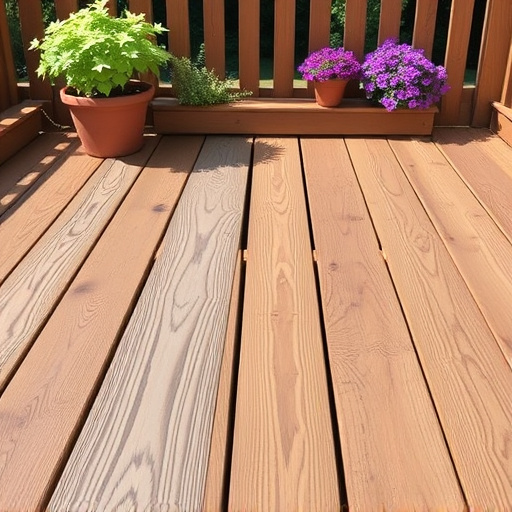
Assess your outdoor space, lifestyle, and surroundings before designing a dream deck. Prioritize fun…….
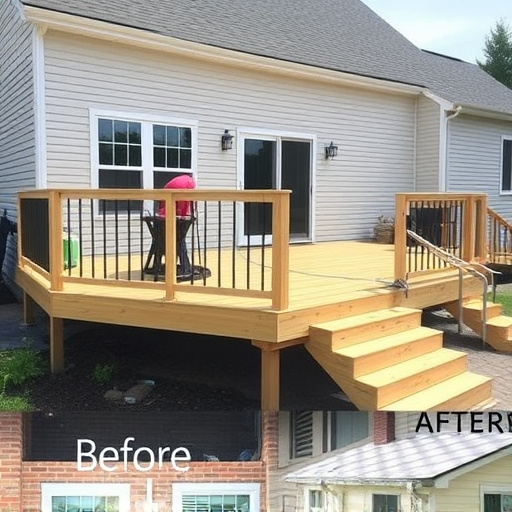
DIY deck design offers cost savings and creative freedom but requires weighing safety risks and mate…….
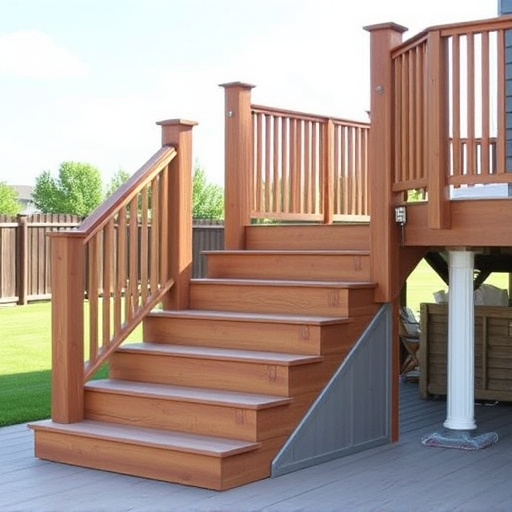
Selecting materials for your deck is key to its beauty and longevity, with wood offering natural cha…….
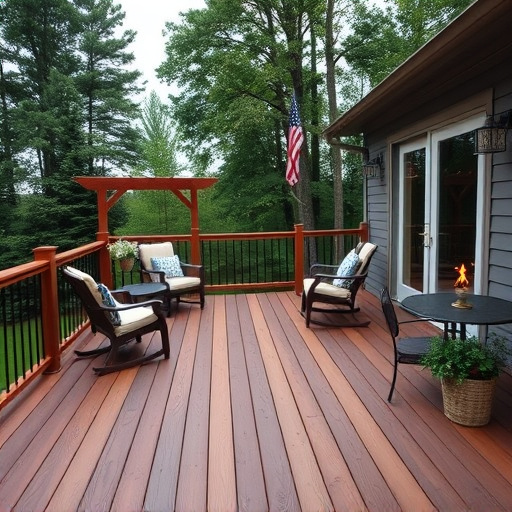
When designing a deck, choose robust materials like composite decking for longevity and low maintena…….
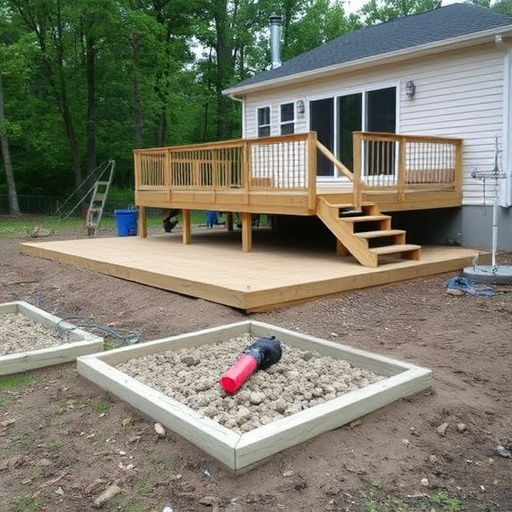
Selecting durable materials like cedar, treated pine, or composite for built-in seating and integrat…….
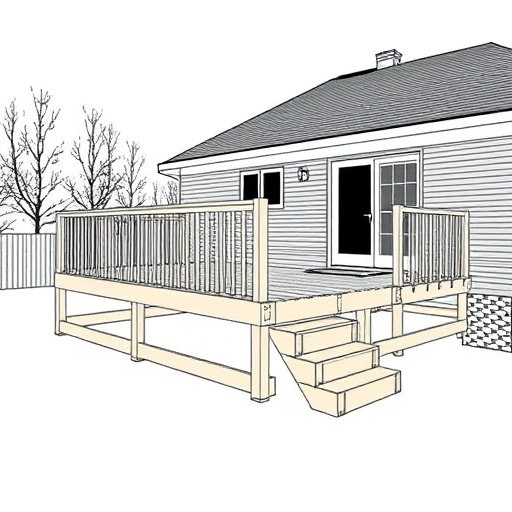
Define deck purpose and style, aligning with home design and intended use. Choose materials, colors,…….